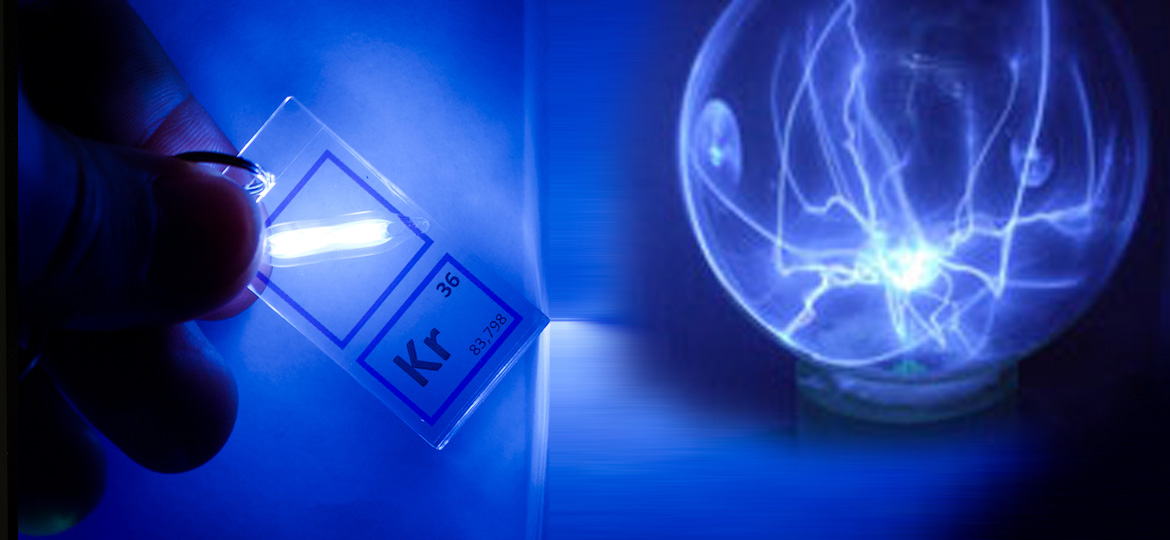

History Krypton Gas
Krypton was discovered in Britain in 1898 by Sir William Ramsay a Scottish chemist and Morris Travers an English chemist in residue left from evaporating nearly all components of liquid air. William Ramsay was awarded the 1904 Nobel Prize in Chemistry for discovery of a series of noble gases, including krypton.
Metric role
In 1960, an international agreement defined the metre in terms of wavelength of light emitted by the krypton-86 isotope. This agreement replaced the longstanding standard metre located in Paris, which was a metal bar made of a platinum-iridium alloy (the bar was originally estimated to be one ten-millionth of a quadrant of the earth's polar circumference), and was itself replaced by a definition based on the speed of light — a fundamental physical constant. In October 1983, the Bureau International des Poids et Mesures (International Bureau of Weights and Measures) defined the meter as the distance that light travels in a vacuum during 1/299,792,458 s.
Occurrence
The Earth has retained all of the noble gases that were present at its formation except for helium. Helium atoms are very light, and move fast enough to escape the Earth's gravity readily.Krypton's concentration in the atmosphere is about 1 ppm. It can be extracted from liquid air by fractional distillation. The amount of krypton in space is uncertain, as is the amount is derived from the meteoritic activity and that from solar winds. The first measurements suggest an overabundance of krypton in space.
Compounds
Like the other noble gases, krypton is chemically unreactive. However, following the first successful synthesis of xenon compounds in 1962, synthesis of krypton difluoride was reported in 1963.There are unverified reports of other fluorides and a salt of a krypton oxoacid. ArKr+ and KrH+ molecule-ions have been investigated and there is evidence for KrXe or KrXe+. At the University of Helsinki in Finland, HKrCN and HKrCCH (krypton hydride-cyanide and hydrokryptoacetylene) were synthesized and determined to be stable up to 40 K.
Isotopes of krypton
There are 20 known isotopes of krypton. Naturally occurring krypton is made of five stable and one slightly radioactive isotope. Its spectral signature can be produced with some very sharp lines. 81Kr, the product of atmospheric reactions is produced with the other naturally occurring isotopes of krypton. Being radioactive it has a half-life of 230,000 years. Krypton is highly volatile when it is near surface waters but 81Kr has been used for dating old (50,000 - 800,000 year) groundwater.
85Kr is an inert radioactive noble gas with a half-life of 10.76 years. It is produced by the fission of uranium and plutonium, such as in nuclear bomb testing and nuclear reactors. 85Kr is released during the reprocessing of fuel rods from nuclear reactors. Concentrations at the North Pole are 30% higher than at the South Pole as most nuclear reactors are in the northern hemisphere.
Formulated to meet the rigorous demands of industrial environments, our specialty gases combine reliability with adaptability. Crafted with exacting purity and performance standards, they perform optimally under the harshest conditions. We offer a wide range of gas options, including Xenon, Silane, and more, with customization available to meet your industry’s specific needs. Whether for manufacturing, electronics, or chemical processes, our gases ensure your operations stay safe, efficient, and productive.
Contact us today to learn how our precision-engineered gases can enhance your processes and ensure top-tier safety and performance!"